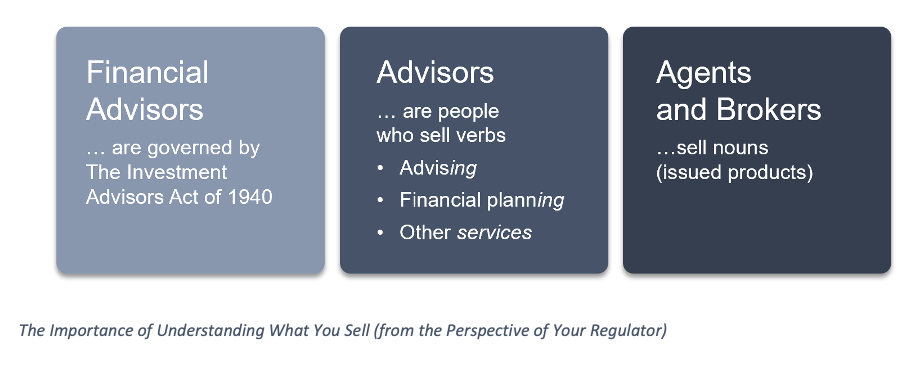By David Macchia
Advisor Perspectives welcomes guest contributions. The views presented here do not necessarily represent those of Advisor Perspectives.
Meet a woman driven to change investment regulation and understand why it’s important that she succeeds.
Michelle Richter is a principal at Fiduciary Insurance Services, LLC, and executive director of the Institutional Retirement Income Council, Inc. She is also one of the smartest people I’ve ever met. Richter’s intellect incorporates both dimensions of “smart,” which is why she was placed in charge of a Fortune 100 company’s broker-dealer and RIA.
Richter is driven. Her “cause” is reform of regulation that levels the playing field for insurance through the introduction of a 40 Act-equivalent governing insurance advisement. I fully support this because it will result in better outcomes for investors. It will facilitate commercialization of intellectual property that, today, represents unfulfilled potential. To help the advisory profession understand the regulatory inequality that exists, Richter developed her own lexicon, using the “verbs” and “nouns” construct.
I spoke with Michelle on May 22.
I was surprised and enlightened to learn about the construct of the verbs and nouns. I didn’t know it was an issue. What brought you to the realization that we needed this?
There were a few things, but mainly, it’s because my experience is as a person who believes in creating value as an intellectual property developer, and that’s where I’ve spent my career. I’ve worked on a lot of consumer-liability-minimizing concepts, which were good concepts from good people who had good ideas. It became increasingly evident that those ideas couldn’t be commercialized.
Why is it that all these good ideas from good people cannot reach the market? I kept applying things that I had learned previously to arrive at this point, which relates to guidance that I received when I was working at a Fortune 100 insurance company, serving as both an intellectual property (IP) developer and overseer of that entity’s corporate broker-dealer and RIA. At the time, when we were developing that intellectual property, my IP counsel advised me on something that over the past few years has hit me like a ton of bricks.
It related to my IP counsel’s interpretation of the distinction between how an entity defends a trademark versus how it defends a service mark.
That’s what caused me to realize something important. At that time, 15 years ago, we had developed unique IP, and my counsel advised me that because the IP would not be embedded directly into an issuable container, that it should be service marked rather than trademarked. If you Google “trademark definition,” what you’ll see is the ability to profit from one of two things: issuance or sale. Sale means direct remuneration. If I’m selling you X, I’m getting paid for X. Inherent to the definition of trademark-ability is that you can either issue or distribute intellectual property. If you can’t profit from the product, then that product is a “noun.” If you can’t profit from the product, either by issuing it or by receiving compensation directly for it by selling it, then you have to service-mark the IP, because it is a service.
Was it a planning concept, as opposed to a product?
It was a framework for the embedding of insurance values into an asset allocation architecture, where you can value either a life insurance policy cash value, or you can translate the income value of an annuity into asset-based values. Then the value of assets, or the value of income that can be translated to assets or vice versa, is advised upon within the product. The income or accumulation value within the product can have the attributes of either fixed or variable investments, perhaps multiple asset classes within that framework. But the framework was designed to include insurance values within an asset-allocation architecture.
Would that be more like a business process?
It’s a great question. It can be monetized that way. It can also be monetized within a managed account or managed model services.
You could use the insurance values as part of the managed model values. Plenty of people, 10 years later, were doing exactly that.
When I was working at that organization, we did not permit registered representatives to sell managed accounts services because we viewed them as services, not as accounts. I was advised by my general counsel that RIAs sell “verbs,” whereas agents and brokers sell “nouns.”
With respect to managed account services, I was advised that the value for which the consumer is paying does not derive from the form of custodial account. It derives from the advising that occurs on the account.
Registered reps who are not dually authorized lack an investment adviser license that enables them to sell verbs.
Registered reps lack an investment adviser license. But RIAs, including IARs of an RIA, do.
 At that time, the essence of the view communicated to me was that things like managed accounts services were verbs. Following from this logic, I believe that the 40 Act governs verb sales, appearing on the left side of the balance sheet, for two reasons. The first is very easy to explain, which is that the 40 Act is short for “investment adviser’s act.”
At that time, the essence of the view communicated to me was that things like managed accounts services were verbs. Following from this logic, I believe that the 40 Act governs verb sales, appearing on the left side of the balance sheet, for two reasons. The first is very easy to explain, which is that the 40 Act is short for “investment adviser’s act.”
Investments are assets. Assets occur on the left side of the balance sheet.
But does anyone disagree with you on that?
There are people who viscerally disagree with me because they have not heard that parlance before. There are also people who feel that the point I am making is very complex, so it is understandable to only a very small audience. They would prefer that I discontinue communicating these points out of fear that I might unintentionally confuse people.
There are also people who feel like I am a nut. That’s a valid viewpoint. But I’ve not yet heard an argument that – from anyone – that says, “No. You’re misunderstanding the world.”
I don’t agree that you’re a “nut.” True passion can come across that way, however.
I concluded that the 40 Act governs verb sales by reviewing how organizations supervise it. They require things like routine, ongoing meetings with the client, because advice can only occur at the end of an advising process. Back in my day, meetings that enabled an advisor to advise had to occur at least annually. Things like that are how we can detect what’s occurring under the 40 Act. Those who have the authority to be an investment adviser are verbs. If we were to look at section 202(a)(11) within the Advisers Act, we’d observe that the words that communicate what an investment adviser does end in “ing.” Because that is the case, we can detect a verb in its present form.
The argument that what financial advisors provide is “advice” (a noun) is logically equivalent to saying that what lawyers provide is “law,” as opposed to “ legal interpreting”.
When we add an “r” to the end of a verb to refer to a person, we are describing the identity of the person who routinely performs an action (a verb). We wouldn’t call a person who once ran across the street a “runner.” We call a person a runner when they routinely run, such that part of their identity can be described by adding an “r” to the end of the verb they routinely perform.
This is another way of saying that an advisor is a person who routinely advises. Professional advising means to give advice in exchange for compensation.
The other side of the balance sheet, which is involved with liability management, is where the noun sellers live.
That’s one place where noun sellers live. Registered representatives are also noun sellers. The 40 Act made it so that there could be both noun and verb sales in financial services. I am not a historian, but as a layperson, I have heard it said that prior to the advent of the 40 Act, consumers were experiencing behavioral challenges with respect to financial professional conduct when there was only a noun-sale framework. It’s unfair to my community, those who identify with liability mitigation, that we are all seen as inexpert product shillers, like how used car salespeople are viewed.
There isn’t a verb-sale framework for liability management. The only way that we’ve seen people who have that expertise in insurance to be able to monetize their experience and their viewpoint is through noun sales. We don’t have a 40 Act for the right side of the balance sheet. We do not yet have a regulatory construct for advising on benefits or income under management. That this is messed up.
If there were a regulatory framework that allowed advisement on the insurance types of products, in a practical sense, what would they be advising on?
One good example would be the income base within a variable annuity, or for an FIA with living benefits, or for a SPIA. Any of those constructs that has a value to annuitization, or a value to an income stream that could be indicated from within the product, could support a billing base for an adviser if it were the case that we valued liability management as a verb. Something that could and would occur in the event of such a framework is the creation of inspired-by-tontining services. We do not yet broadly have tontining in the United States. We are behind the rest of the developed world in this development of non-guaranteed longevity risk mitigating products or services because we do not have the required regulatory framework. If we had the correct regulatory framework, we would already have a collective defined contribution tontining product (other than what is available from TIAA). Tontining is non-guaranteed risk-pooling for longevity benefits from which you can’t charge a large fee, because the whole premise is about efficiency. For those organizations that have invested in the noun part, which means issuing and/or distributing authority, successful products occur at the intersection of three things: novel intellectual property, issuing authority, and previous investment in distribution – a whole-saleing architecture.
When either a financial professional or an issuing organization can only profit from the noun in the sphere of liability mitigation in the way I just described, then there’s no value to intellectual property, because the issuing authority has to meet the needs of the previous investment in wholesaling. It would make no sense for an issuing organization that has made this substantial investment in distribution to create, and to promulgate, a noun that’s less profitable than is its incumbent portfolio of nouns. The efficient, low-cost asset managers, like Vanguard and Dimensional, came to exist only after there was a 40 Act, and only in the context of the RIA community. RIAs were not being paid from inside the noun. The service of advising is paid based upon the AUM or based upon notional assets that are advised upon, which is to say, upon which advisory services are delivered by a professional.
RIAs are paid for providing a service to their clients from outside the noun structure. All services are verbs.
Because my words are true, there can be no such thing in my field as valuable intellectual property. I experience offense at that.
Imagine that you had a magic wand, and a new regulatory framework appeared tomorrow for agents selling fixed-index annuities.
There would be no protection whatsoever. No financial institution to stand with them as a co-fiduciary under PTE2020-02 for qualified sales.
Let’s say that it existed. Say an agent working with a family consummated a $250,000 transaction to purchase an FIA. What would the latitude be? What would the compensation scheme look like? What would the responsibilities of advisement be in that scenario?
I believe in sentences. The insurance field has parity with the investment field, meaning that we have access to both noun and verb sales. I want to be clear about the fact that no judgment is occurring upon those of us who earn our compensation from selling nouns.
Let’s imagine it comes to be the case that insurance – liability mitigation orientation – is orchestrated around the advising premise as it differs from the product-sales premise. In this world, the placement of the FIA transaction is not the basis for the remuneration that the insurance liability adviser receives. Another way of thinking about that is what the financial planner receives. The value proposition in this case would be the fact that the adviser, the liability adviser, has worked with the client to understand what their needs are. They may recommend that indexed annuity. They may use today’s regulatory framework and get a commission from that. It could be perfectly appropriate. Alternatively, but never concurrently, as is true in the investment space, in my alternative reality, they could and should be able to charge the client on the value creation of the management of that person’s liabilities, instead of the commission that they could receive from the noun within that advising context. Either, but not both concurrently, should be valid compensation constructs available to financial and insurance professionals.
The broader scope of using that is as a strategic tool to manage a certain set of liabilities that the person or individuals have.
Right. That fits well with the premise of codifying financial planning as a discipline.
In part two of this interview, Richter addresses financial planning, the usage of annuities by RIAs, regulatory implications, and more.
Wealth2k® founder David Macchia is an entrepreneur, author, IP inventor and public speaker whose work involves improving the processes used in retirement income planning. David is the developer of the widely used The Income for Life Model®, and the recently introduced Women And Income®. David has authored many articles on the subjects of retirement income planning and financial communications. He is the author of two books, Constrained Investor®, and Lucky Retiree: How to Create and Keep Your Retirement Income with The Income for Life Model®.
View te full article, here: https://www.advisorperspectives.com/articles/2022/05/30/are-you-selling-a-verb-or-a-noun
 That Annuity Show
That Annuity Show






















Recent Comments